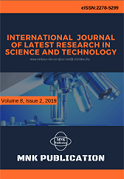DOI:10.29111/ijlrst ISRA Impact Factor:3.35, Peer-reviewed, Open-access Journal
Research Paper Open Access
International Journal of Latest Research in Science and Technology Vol.4 Issue 2, pp 171-179,Year 2015
Correspondence should be addressed to :
Received : 18 April 2015; Accepted : 25 April 2015 ; Published : 30 April 2015

| Download | 125 |
|---|---|
| View | 178 |
| Article No. | 10515 |
In impairedglucosetolerance (IGT) –a major risk factor for the development of type 2 diabetes mellitus (DM)–reportedcomplicationsincluderetinopathy, renal disease, polyneuropathy and dyslipidemia. Additionally, impaired β cell function has been demonstrated. Renal diseasemay be related to local insulinaction, as itstimulatessodiumreabsorption and nitric oxide production. Recently, we found that rat kidneys are able to produce insulin as well as the Pdx-1 and Nkx6.1 transcription factors, which play a key role in differentiation of β-cells and insulin expression, under standard physiological conditions. In this work, we investigated the expression of insulin and its related transcription factors in the kidneys of rats which were administered a 30% sucrose solution for six months, to induce an IGT model. Theseanimalsshowed a significantdecrease in the renal genicexpression of insulin and itsrelatedtranscriptionfactors and consequently, a decline in itstissuedetectionthroughimmunohistochemistry. Also, IGT animals showed renal tissue damage at the cortex and medulla. In addition to IGT, sucrosetreatedratspresentedhyperinsulinemia, increasedtryglicerides and a decrement in HDL blood levels. We suggest that as in the pancreas, IGT leads to a decline in local insulinproduction in thekidney and thereforeanimpairment in sodiumreabsorption and nitric oxide production. This may contribute to kidney tissue damage.
Copyright © 2015 Claudia Soto et al. This is an open access article distributed under the Creative Commons Attribution 4.0 International (CC BY 4.0) license which permits unrestricted use, distribution, and reproduction in any medium, provided the original work is properly cited.
Claudia Soto,JesúsJuárez, Imelda González, Esther UrÃa,Luis Raya, Mónica Ruiz, Natalia GarcÃa , " Insulin Gene Expression And Its Detection In The Kidneys Of Rats With Impaired Glucose Tolerance ", International Journal of Latest Research in Science and Technology . Vol. 4, Issue 2, pp 171-179 , 2015

MNK Publication was founded in 2012 to upholder revolutionary ideas that would advance the research and practice of business and management. Today, we comply with to advance fresh thinking in latest scientific fields where we think we can make a real difference and growth now also including medical and social care, education,management and engineering.

We offers several opportunities for partnership and tie-up with individual, corporate and organizational level. We are working on the open access platform. Editors, authors, readers, librarians and conference organizer can work together. We are giving open opportunities to all. Our team is always willing to work and collaborate to promote open access publication.

Our Journals provide one of the strongest International open access platform for research communities. Our conference proceeding services provide conference organizers a privileged platform for publishing extended conference papers as journal publications. It is deliberated to disseminate scientific research and to establish long term International collaborations and partnerships with academic communities and conference organizers.